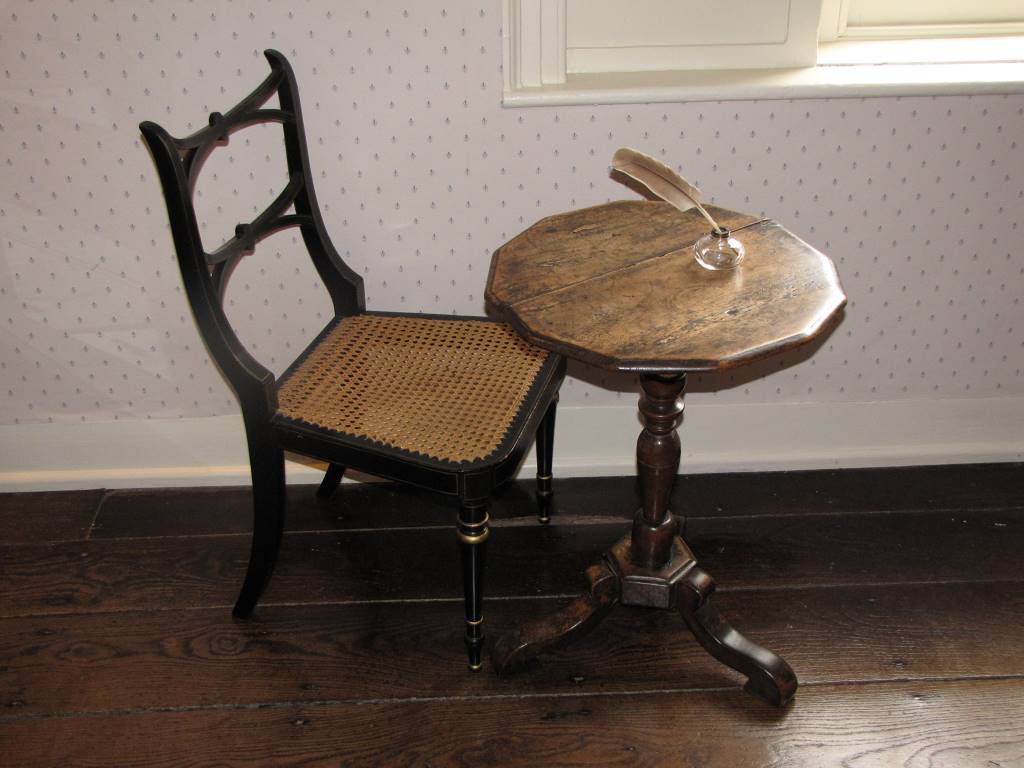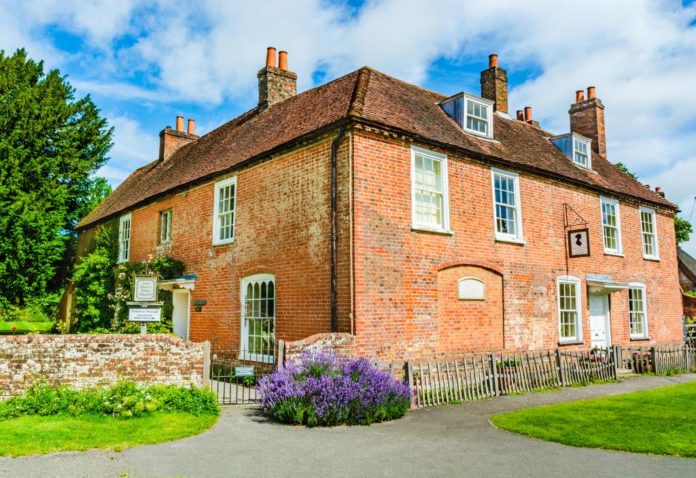Jane Austen’s timeless charm lives on even in 2023, with fans all over the globe. We visited the novelist’s home village and discovered her much-loved local haunts
By Monica Woods
A lofty lime tree marks the spot where Steventon Rectory once stood – the place where the country’s favourite author, second only to Shakespeare, spent the first 25 years of her life. Jane Austen’s roots run deep in this pretty part of the world, known for its traditional thatched cottages, gently rolling hills and chalk streams. It was in Chawton, a small, picturesque village in east Hampshire, that Jane was happiest, and most prolific. She was proud to call herself “a Hampshire-born Austen”, and the county shares its pride in its literary daughter with a host of sights, attractions and trails.
Of course, Jane Austen’s six novels (seven, if you count the unfinished Sanditon) are cherished the world over, and each new film or TV adaptation introduces her work to a fresh audience. Recently, Emma has enjoyed another silver-screen outing, directed by Autumn de Wilde and scripted by Man Booker Prize-winning author Eleanor Catton. Filming did not actually take place in Hampshire, but Chavenage House in nearby Gloucestershire was used as a location (Poldark fans may recognise the Elizabethan country pile). In fact, dear as the county was to Jane’s heart, actual Hampshire place names rarely crop up in her novels; Portsmouth features in Mansfield Park but Emma is set in the fictional Highbury.
The 2017 bicentenary of Austen’s death heralded a wave of new events, exhibitions and publications, but dedicated fans from every corner of the globe have long been making the pilgrimage to Jane Austen’s House Museum in Chawton.

It was in this modest, rust-red brick cottage that Jane lived with her sister Cassandra, their mother, and family friend Martha Lloyd, from 1809 to 1817. The move was made possible by Jane’s brother, Edward, who had become heir of the wealthy Knight family and inherited nearby Chawton House and estate. For Jane it was a welcome return to countryside life after her father’s retirement, and later death, had prompted moves first to Bath, then to Southampton. While these livelier environs may have provided ample material for her work, Jane was only able to pick up her quill in earnest again once she had settled at Chawton.
The museum celebrated its 70th year in 2019 – its collection was launched in 1949 with an appeal in local newspapers for Austen-related items – and provides a charming insight into daily life for the Austen household. If you’re lucky, your visit may coincide with volunteer guide Jeremy Knight, Jane’s great-great-great-great nephew, being on duty. Either way, it’s a delight to wander round the house and garden, admiring treasures such as the bookcase that once belonged to the Reverend George Austen, the topaz crosses given to Jane and Cassandra by their brother Charles, and the small, twelve-sided walnut table on which Jane wrote Emma, Mansfield Park and Persuasion.
The famous writing table is positioned at the dining parlour window, where Jane preferred to work. While she may have benefited from the daylight (as well as the opportunity for people watching), the present-day country road was at that time the main Winchester to London thoroughfare, with carriages noisily rattling past. For a change of scenery, Jane could stroll up to the ‘Great House’, her brother’s residence, only a short walk from the cottage but representing an entirely different way of life.

While the Austen women dwelled in genteel yet straitened circumstances, Edward had joined the ranks of the Regency rich. Chawton House is a Grade II-listed Elizabethan manor with gardens featuring formal terraces, a cultivated ‘wilderness’ and shrubbery. The contrast between the two homes is clear – and no doubt provided a rich seam of material for Jane’s novels. As you make your way from the museum, past diminutive thatched cottages and lush green meadows, before turning left to glimpse the sweeping drive and handsome 16th-century facade of Chawton House, it’s hard not to think of Elizabeth Bennett catching sight of Pemberley for the first time.
The house has been developed over the centuries, with additions such as wood panelling for enhanced Tudor appeal, but still exudes the warmth and comfort of a family home. Indeed, it was lived in until the late 20th century (the aforementioned Jeremy Knight remembers Edward’s silk suit, now on display, being in the dressing-up box). Family lore has it that Jane liked to sit in the Oak Room – the cosy alcove with a view over the drive certainly looks inviting.
Today the house throws open its doors to ‘Janeites’ and academics alike – its library is dedicated to women’s writing. It seems fitting that Jane’s books now sit on the shelves of her brother’s house, alongside other female writers including Aphra Behn, Frances Burney and Mary Shelley, as well as less well-known names. After a ramble around the house, you can continue to soak up the atmosphere over tea and cake in the Old Kitchen Tearoom before visiting St Nicholas Church, where Jane’s mother and sister are buried.

The nearby market town of Alton – now location for the Jane Austen Regency Week every June – would have been a regular shopping haunt for the Austen sisters. Nowadays, Alresford (pronounced Allsford) is a more popular shopping destination – pastel-coloured buildings along Broad Street house independent boutiques and watering holes – as well as being the UK’s capital of watercress farming. The best way to cover the ten miles southwest from Alton is by steam train, aboard the heritage Watercress Line. This patch of Hampshire has no shortage of stately homes and attractive landscapes, descriptions of which could be lifted from the pages of Austen’s novels.
In springtime, don’t miss the beautiful bluebell wood at the National Trust’s Hinton Ampner, near Alresford. Elsewhere, the beech woods and flower meadows of Selborne Common provided inspiration for Gilbert White (1720–1793), the pioneering naturalist who lived in the village of Selborne, south of Chawton. His record of the local landscape and wildlife, The Natural History of Selborne, published in 1789, has never been out of print.
But to faithfully continue in Jane’s footsteps, head a little further north to The Vyne, another National Trust property, near Basingstoke. Many illustrious visitors have called at this impressive Tudor manor, one of the most grand and least altered in the county: King Henry VIII, Anne Boleyn, Catherine of Aragon, Horace Walpole, and Jane Austen. Growing up in nearby Steventon, Jane was acquainted with The Vyne’s owners, the Chute family, and she attended dances here.
Jane was working on her seventh novel, Sanditon, when her deteriorating health demanded a move away from her beloved Chawton to Winchester, to be closer to her doctor. A blue plaque at 8 College Street marks the place where she took her final breaths in July 1817, aged only 41, but the house itself is not open to the public. Jane was buried in nearby Winchester Cathedral; her tombstone makes no mention of her writing – the books released during her lifetime were all published anonymously – but the later additions of a brass plaque and commemorative stained-glass window make some amends.

Needless to say, other figures loom large in Winchester, from Alfred the Great to King Arthur. After admiring the soaring Gothic lines of the cathedral, and the Antony Gormley sculpture in its crypt, wander through the evocative ruins of Wolvesey Castle before heading for the Great Hall. The sole surviving remnant of Winchester Castle, it is here where King Arthur’s legendary Round Table has hung for centuries. You’d think a 1,200kg medieval tabletop might outshine the small wooden occasional table given pride of place at Jane Austen’s House Museum, but legions of Janeites would surely disagree.
Read more:






 © 2024
© 2024